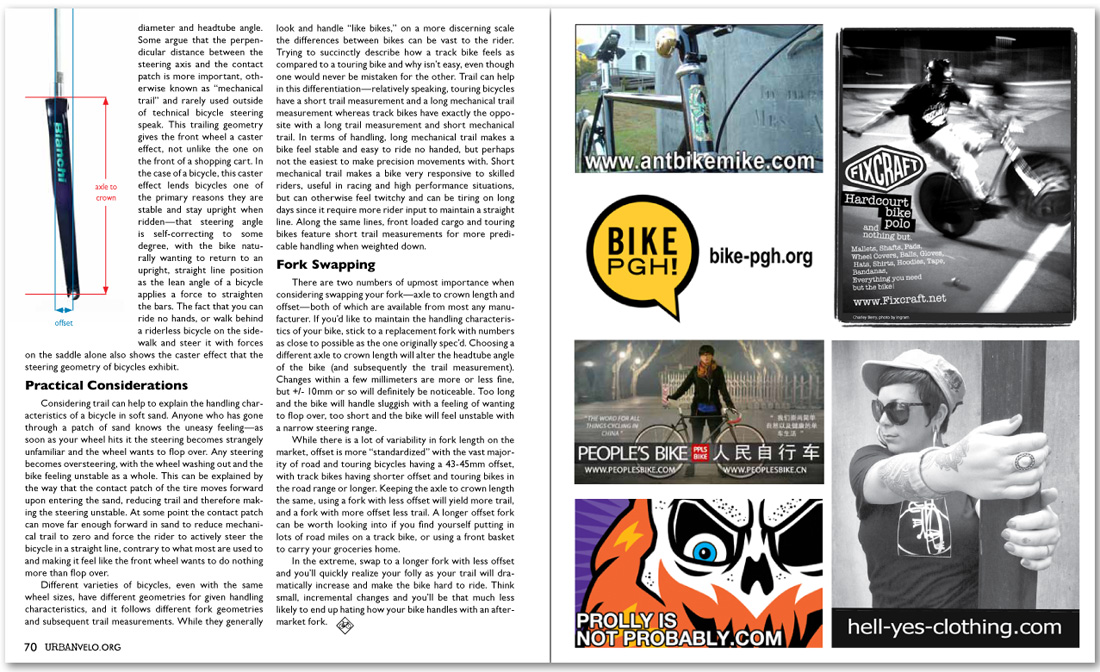


Practical Considerations
Considering trail can help to explain the handling characteristics of a bicycle in soft sand. Anyone who has gone through a patch of sand knows the uneasy feeling—as soon as your wheel hits it the steering becomes strangely unfamiliar and the wheel wants to flop over. Any steering becomes oversteering, with the wheel washing out and the bike feeling unstable as a whole. This can be explained by the way that the contact patch of the tire moves forward upon entering the sand, reducing trail and therefore making the steering unstable. At some point the contact patch can move far enough forward in sand to reduce mechanical trail to zero and force the rider to actively steer the bicycle in a straight line, contrary to what most are used to and making it feel like the front wheel wants to do nothing more than flop over.
Different varieties of bicycles, even with the same wheel sizes, have different geometries for given handling characteristics, and it follows different fork geometries and subsequent trail measurements. While they generally look and handle “like bikes,” on a more discerning scale the differences between bikes can be vast to the rider. Trying to succinctly describe how a track bike feels as compared to a touring bike and why isn’t easy, even though one would never be mistaken for the other. Trail can help in this differentiation—relatively speaking, touring bicycles have a short trail measurement and a long mechanical trail measurement whereas track bikes have exactly the opposite with a long trail measurement and short mechanical trail. In terms of handling, long mechanical trail makes a bike feel stable and easy to ride no handed, but perhaps not the easiest to make precision movements with. Short mechanical trail makes a bike very responsive to skilled riders, useful in racing and high performance situations, but can otherwise feel twitchy and can be tiring on long days since it require more rider input to maintain a straight line. Along the same lines, front loaded cargo and touring bikes feature short trail measurements for more predicable handling when weighted down.
Fork Swapping
There are two numbers of upmost importance when considering swapping your fork—axle to crown length and offset—both of which are available from most any manufacturer. If you’d like to maintain the handling characteristics of your bike, stick to a replacement fork with numbers as close to possible as the one originally spec’d. Choosing a different axle to crown length will alter the headtube angle of the bike (and subsequently the trail measurement). Changes within a few millimeters are more or less fine, but +/- 10mm or so will definitely be noticeable. Too long and the bike will handle sluggish with a feeling of wanting to flop over, too short and the bike will feel unstable with a narrow steering range.
While there is a lot of variability in fork length on the market, offset is more “standardized” with the vast majority of road and touring bicycles having a 43-45mm offset, with track bikes having shorter offset and touring bikes in the road range or longer. Keeping the axle to crown length the same, using a fork with less offset will yield more trail, and a fork with more offset less trail. A longer offset fork can be worth looking into if you find yourself putting in lots of road miles on a track bike, or using a front basket to carry your groceries home.
In the extreme, swap to a longer fork with less offset and you’ll quickly realize your folly as your trail will dramatically increase and make the bike hard to ride. Think small, incremental changes and you’ll be that much less likely to end up hating how your bike handles with an aftermarket fork.